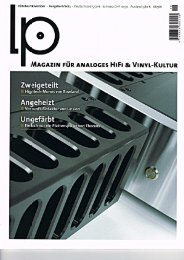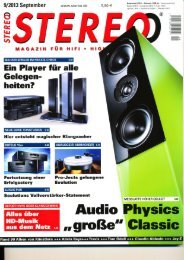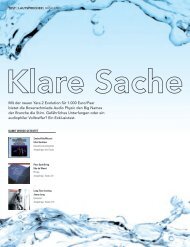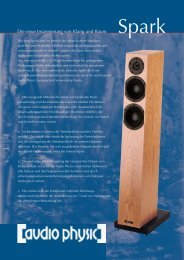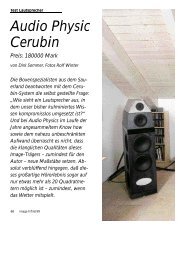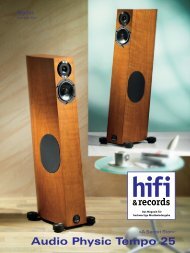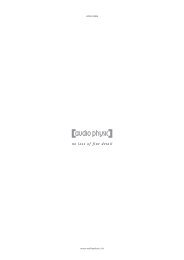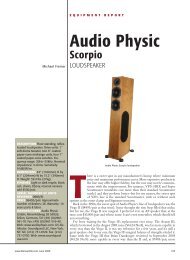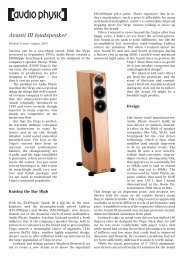RUNDE SACHE - Audio Physic
RUNDE SACHE - Audio Physic
RUNDE SACHE - Audio Physic
Create successful ePaper yourself
Turn your PDF publications into a flip-book with our unique Google optimized e-Paper software.
Test & Technik I Lautsprecher<br />
<strong>RUNDE</strong><br />
<strong>SACHE</strong><br />
In der Avanti 5 reaktiviert <strong>Audio</strong><br />
<strong>Physic</strong> einen Treibertyp aus der HiFi-<br />
Gründerzeit,einen Konushochtöner.<br />
Doch gerade der sorgt für einen zukunftsweisend<br />
entspannten Klang.<br />
Test: Holger Biermann Fotos: Julian Bauer, Hersteller<br />
B<br />
ei HiFi-Journalisten ist Manfred Diestertich ein<br />
gern gesehener Gast. Gleich, ob in den vielen Jahren<br />
bei IQ oder nun bei <strong>Audio</strong> <strong>Physic</strong>, ist der passionierte<br />
Highender und Querdenker stets ein Quell neuer<br />
Ideen und Ansätze für den noch besseren Klang.<br />
Das Beste ist gerade gut genug: Die NextGen-Anschlüsse<br />
von WBT gibt es auf Wunsch auch in Bi-Wiring. Die vier<br />
Spikes sind von oben zugänglich und so perfekt einstellbar.<br />
28<br />
stereoplay 3/2007<br />
www.stereoplay.de<br />
Mal erfindet er die SSC-Entkopplung (String Suspension<br />
Concept), ein anderes Mal den wohl weltbesten<br />
Mittelhochton-Koax – zu finden im <strong>Audio</strong>-<br />
<strong>Physic</strong>-Flaggschiff Kronos. Kurz: Diestertich’sche<br />
Lautsprecher sind immer etwas Besonderes.<br />
Die neue Avanti 5 macht da keine Ausnahme und<br />
bietet jede Menge highendige Leckerbissen. Zum Beispiel<br />
das anspruchsvolle Gehäuse, das der dänische<br />
Spezialist Hornslet in höchst raffinierter Hornflex-<br />
Technik aufbaut. Dabei werden MDF-Feinspanplatten<br />
mit Längsfräsungen versehen, sodass man sie<br />
problemlos biegen kann – siehe unten. Die finale<br />
Gehäusekonstruktion ist ein an vielen Stellen versteiftes<br />
Gebilde, das viel mehr ist als nur der notwendige<br />
Kasten um die Chassis. Diestertich: „Das Gehäuse<br />
trägt wesentlich zum Klang des Lautsprechers bei<br />
und wird zukünftig noch viel mehr in die Entwicklung<br />
mit einfließen.“ Die moderne Simulations-Software<br />
macht’s möglich.Trotzdem ging der Entstehung des<br />
Gehäuses ein mühseliger Hör- und Entwicklungsprozess<br />
voraus, weshalb die Avanti 5 länger auf sich<br />
warten ließ als gedacht und der frühere Testtermin bis<br />
zu diesem Heft verschoben werden musste.<br />
Die Konstruktionszeichnung zeigt die hohe Komplexität<br />
des Avanti-5-Gehäuses. Die Rundungen der Rückseite<br />
werden durch die gefräste MDF-Platte (Pfeil) ermöglicht.<br />
www.stereoplay.de stereoplay 3/2007 29<br />
»
Test & Technik I Lautsprecher<br />
Interview<br />
„Mehr Kontrolle<br />
dank Konus“<br />
Back to the roots? Der neue<br />
<strong>Audio</strong> <strong>Physic</strong>-Hochtöner HH-<br />
CT (Hyper Holographic Cone<br />
Tweeter) ist ein Konushochtöner<br />
(Durchmesser: 38 Millimeter),<br />
wie ihn nur noch die<br />
Älteren unter uns oder die<br />
Besitzer absoluter Billigboxen<br />
kennen. Dabei hat sich<br />
im High End doch weltweit<br />
die Kalotte durchgesetzt.<br />
stereoplay: Herr Diestertich,<br />
warum reaktivieren Sie denn<br />
diesen längst verstoßenen<br />
Treibertypus?<br />
MD: Auch die Kalotte hat ja<br />
nicht nur Vorteile. Prinzipbedingt<br />
sitzt ihre Schwingspule<br />
am Dom-Ansatz und<br />
damit direkt neben der Sicke.<br />
Ein Großteil der Schwingspulen-Energie<br />
wird so gleich<br />
wieder bedämpft. Auch neigen<br />
Kalotten eher zu Taumelbewegungen.<br />
Mit dem Ko-<br />
30<br />
2<br />
stereoplay 3/2007<br />
Für einen Ko-<br />
nus sehr breit-<br />
1<br />
nus habe ich mehr Kontrolle<br />
und eine höhere Effizienz.<br />
stp: Konus-Hochtöner sind<br />
auch deshalb aus der Mode,<br />
weil sie meist stark bündeln!<br />
MD: Auch dieser Konus bündelt<br />
ab 4 KHz, aber nicht<br />
stark, und er läuft weit hoch.<br />
Einen solchen Übertragungsbereich<br />
erreiche ich mit herkömmlichen<br />
Kalotten nicht.<br />
stp: Die niedrige Eigenresonanz<br />
von 850 Hertz würde<br />
eine niedrige Übergangsfrequenz<br />
erlauben...<br />
MD: ...aber ich setze ihn erst<br />
bei 3 Kilohertz ein, stimmt.<br />
Aber so bekomme ich hohe<br />
Dynamik-Reserven und niedrige<br />
Verzerrungswerte.<br />
bandig. Der<br />
linearste Fre-<br />
quenzgang<br />
entsteht bei<br />
einer An-<br />
winkelung von<br />
Hat gut lachen: Mit dem Konus-<br />
Hochtöner gelang <strong>Audio</strong>-<strong>Physic</strong>-<br />
Entwickler Manfred Diestertich<br />
erneut ein echtes Meisterstück.<br />
20 Grad .<br />
0 hoch 30 seitlich<br />
mpedanzverlauf<br />
1 kHz 10 kHz 40<br />
Der HHCD ist ein 38-Millimeter-Konus (1) mit Staubschutzkalotte<br />
(2) in der Mitte und effizientem Neodymmagnet-Antrieb (3).<br />
3<br />
Hier zeigen sich die Schattenseiten<br />
des Besonderen:<br />
Sogar die Gehäuseprofis von<br />
Hornslet können – trotz CNCund<br />
CAD-Bestausstattung –<br />
ein solch komplexes Werk nicht<br />
Von wegen Avanti! Die No 5<br />
kam viel später als geplant<br />
über Nacht in Perfektion entwickeln.<br />
Auch der Hochtöner<br />
(siehe Kasten links) brauchte<br />
lange von der Diestertich’schen<br />
Idee bis zur perfekten Umsetzung<br />
vom norwegischen Edelzulieferer<br />
Seas.<br />
Und damit sind wir schon<br />
bei der Bestückung der neuen<br />
Avanti: Jede Box besitzt vier<br />
Bässe (zwei rechts, zwei links),<br />
zwei Mittel- und einen Hochtöner.<br />
Alle sieben sind Konus-<br />
Treiber mit Aluminium-Membranen.<br />
Es geht dabei um<br />
Homogenität. Unter Profis hat<br />
sich längst die Erkenntnis<br />
breit gemacht, dass Chassis mit<br />
gleichen Membranmaterialien<br />
besonders gut zusammenspielen:<br />
stereoplays neue Lautsprecher-Referenz<br />
Lumen White<br />
Silver Flame (12/06) arbeitet ja<br />
mit Tief-, Mittel- und Hochtönern,<br />
die alle drei mit Keramikmembranen<br />
bestückt sind.<br />
Diestertich verwendet in der<br />
Avanti 5 nicht nur durchweg<br />
Aluminium, sondern auch die<br />
gleiche Bauform (Konus).<br />
Das Messlabor weist die<br />
Avanti 5 als klassische 4-Ohm-<br />
Box mittleren Wirkungsgrads<br />
aus.Aber die Messungen zeigen<br />
auch, dass der Frequenzgang<br />
noch linearer sein könnte: Der<br />
starke Anstieg oberhalb von 20<br />
Kilohertz wird in der Regel als<br />
angenehm empfunden, aber die<br />
Anhebung von 4 Dezibel bei<br />
500 Hertz trübt das Bild.<br />
Und trotzdem verzauberte<br />
uns die Avanti aus dem Stand<br />
heraus. Sie schuf ein völlig von<br />
den Gehäusen gelöstes, unerschütterlich<br />
ruhiges Klangbild<br />
mit prallen Farben und mit<br />
großer Raumtiefe. Unsere vorzüglichen<br />
Arbeits-Referenzen<br />
Thiel CS 2.4 (9/03) und <strong>Audio</strong>data<br />
Avancé (11/04) waren in<br />
vielen Teilbereichen – vor allem<br />
bei der plastischen Darstellung<br />
– wenigstens ebenbürtig, aber<br />
unterm Strich chancenlos. Die<br />
Avanti 5 hatte kaum mehr Bass,<br />
klang aber voller, sie zeigte<br />
kaum mehr Details und klang<br />
doch feiner. Sie hatte diesen<br />
Grundtonbuckel und zeichnete<br />
doch Stimmen von packender<br />
Authenzität.<br />
Auch im Vergleich zur objektiv<br />
eindeutig überlegenen B&W<br />
802 D (6/05) zeigte sich, dass<br />
1<br />
3<br />
2<br />
www.stereoplay.de<br />
Tiefbässe durchaus noch satter,<br />
dynamischer und strukturierter,<br />
dass der Grundton weniger wolkig<br />
und dass Vibraphon-Anschläge<br />
(Stück 6 der stereoplay-Titel-<br />
CD 6/06) noch „reiner“ klingen<br />
können.Aber auch schöner?<br />
Nach langem Hören gaben<br />
wir den Versuch auf, die klanglichen<br />
Vorzüge der Avanti 5 an Einzelpunkten<br />
festmachen zu wollen.<br />
Wo andere Lautsprecher zwar<br />
dynamischer, aber auch<br />
nervöser spielen, erzeugt<br />
sie – ähnlich der Linn<br />
Komri aus Heft 2/07 – eine<br />
entspannte Stimmung,<br />
ein Wohlgefühl, bei dem<br />
man Musik hören und<br />
nicht Erbsen zählen<br />
möchte. Oder wie es<br />
stereoplays Digitalexperte<br />
Uli Fessler for-mulierte:<br />
„Die will ich.“ ■<br />
1 Der Konus-Hochtöner<br />
ist nach hinten offen und<br />
hat deshalb ein eigenes<br />
Gehäuse. So sinkt seine<br />
Eigenresonanz auf 850<br />
Hertz.<br />
2 Die unregelmäßigen<br />
Wände des Mitteltongehäuses<br />
wirken wie<br />
Diffusoren, weshalb<br />
Diestertich hier fast<br />
ohne Dämmstoff auskommt.<br />
3 Der Bassbereich<br />
besteht aus vier 7-<br />
Zoll-Tieftönern (zwei<br />
pro Seite) in Push-<br />
Push-Ansteuerung.<br />
Da sich die jeweils<br />
gegenüberliegenden<br />
Bässe in ihrer<br />
Bewegung fast neutralisieren,<br />
ist das<br />
Gehäuse sehr<br />
vibrationsarm.<br />
www.stereoplay.de<br />
<strong>Audio</strong> <strong>Physic</strong> Avanti 5<br />
10000 Euro (Herstellerangabe)<br />
Vertrieb: <strong>Audio</strong> <strong>Physic</strong>, Brilon<br />
Telefon: 02961/96170<br />
www.audiophysic.de<br />
Maße: B:24 x H:111 x T:42 cm<br />
Gewicht: 40 kg<br />
Aufstellungs-Tipp: Frei, mit größerem<br />
Abstand (mehr als 50 cm) zu den<br />
Seitenwänden. Für Räume bis 45 m2 .<br />
Messwerte<br />
Frequenzgang & Impedanzverlauf<br />
100 dB<br />
90 dB<br />
80 dB<br />
70 dB<br />
60 dB<br />
Leichte Betonung um 600 Hz, sonst ausgewogen<br />
mit sehr hoch rauf reichendem<br />
Verlauf; Impedanzminimum 3,4 Ohm<br />
Frequenzgang & Klirr 85-100 dB SPL<br />
Im Bass sehr geringer, um 500 Hz und<br />
ab 2 kHz dagegen erhöhter Klirrr<br />
Benötigt für HiFi-gerechte Lautstärken<br />
Verstärker ab 27 Watt an 3 Ohm<br />
Untere Grenzfrequenz -3dB 52 Hz<br />
Maximallautstärke >52 Hz 107 dB<br />
14<br />
10<br />
6<br />
2 Natürlichkeit<br />
axial 10 hoch 30 seitlich<br />
2 Ohm<br />
Impedanzverlauf<br />
50 dB<br />
1 Ohm<br />
10 Hz 100 Hz 1 kHz 10 kHz 40 kHz<br />
100 dB<br />
90 dB<br />
80 dB<br />
70 dB<br />
60 dB<br />
y q g g<br />
Feinauflösung<br />
Grenzdynamik<br />
Bassqualität<br />
stereoplay 3/2007<br />
Abbildung<br />
16 Ohm<br />
8 Ohm<br />
4 Ohm<br />
<strong>Audio</strong> Physik Avanti Klirrverlauf<br />
110 dB<br />
50 dB<br />
20 Hz 40 Hz 100 Hz 200 Hz 500 Hz 1 kHz 2 kHz 4 kHz<br />
stereoplay Bedarfsprofil<br />
8Ω<br />
14W<br />
6Ω<br />
18W<br />
4Ω<br />
27W<br />
3Ω<br />
27W<br />
2Ω<br />
-<br />
0 20W 100W 500W 1000W<br />
Bewertung<br />
13 13 11 11 13<br />
Klang (max.70 Punkte) 61 Punkte<br />
0 10 20 30 40 50 60 70<br />
Messwerte (max.10 Punkte) 7<br />
Praxis (max.10 Punkte) 4<br />
Wertigkeit (max.10 Punkte) 9<br />
Elegante Standbox mit Bass-Seitentreibern.<br />
Feinsinniger, geschmeidiger<br />
und sehr entspannter Klang.<br />
stereoplay Testurteil<br />
Klang<br />
Absolute Spitzenklasse 61 Punkte<br />
Gesamturteil:<br />
sehr gut 81 Punkte<br />
Preis/Leistung überragend<br />
31
Test &Technology I Loudspeaker<br />
PERFECT<br />
IN ITSELF<br />
With the Avanti 5 <strong>Audio</strong> <strong>Physic</strong> goes<br />
back to the roots and re-activates a<br />
driver design from HiFi pioneer times. It<br />
is this remarkable step which brings<br />
forth a trend-setting and relaxing sound.<br />
Test by: Holger Biermann, Photos by: Julian Bauer, manufacturer<br />
HiFi journalists simply love to have Manfred<br />
Diestertich as a guest. After having worked for IQ<br />
for many years, he became <strong>Audio</strong> <strong>Physic</strong>’s chief<br />
designer where the high-end aficionado remained<br />
true to his concept of lateral thinking and a<br />
constant source of new ideas and impetus in the<br />
pursuit of even better sound.<br />
The best is just enough: The WBT NextGen plugs are<br />
also available for bi-wiring. The four spikes can be<br />
perfectly adjusted from above.<br />
One day he developed the String Suspension<br />
Concept, the next day he came up with probably<br />
the best coaxial midrange driver in the word -<br />
which has been implemented in the Kronos, the<br />
<strong>Audio</strong> <strong>Physic</strong> flagship. In short, loudspeakers<br />
designed by Diestertich are quite something<br />
special.<br />
The new Avanti 5 does not fall short of the<br />
mark and holds a bountiful of treats to high-end<br />
listeners such as the sophisticated cabinet<br />
produced by the Danish manufacturer Hornslet<br />
which used its patented Hornflex technique to<br />
achieve the challenging design. This technique<br />
permits the milling of straight lines so that later<br />
the MDF boards can be easily bent - see below.<br />
The resulting cabinet is characterised in many<br />
places by rigid structures which is much more<br />
complex than an enclosure just necessary to<br />
mount the drivers. "The cabinet itself also has a<br />
considerable audible effect on the sound of a<br />
loudspeaker. Therefore it will play a much<br />
greater role in future development”, said<br />
Diestertich. And this is all made possible through<br />
the use of modern simulation software. However<br />
it took innumerable hearing sessions and<br />
tedious development processes to create the<br />
Avanti 5. All in all it took more time than<br />
expected forcing us to postpone the test review<br />
until this issue.<br />
»<br />
The design drawing shows the high complexity of the<br />
Avanti 5 cabinet. The rounded rear of the cabinet is<br />
made possible by using machined MDF boards (arrow).<br />
28 stereoplay 3/2007 www.stereoplay.de www.stereoplay.de stereoplay 3/2007 29
Test & Technology I Loudspeaker<br />
Interview<br />
“Cone for<br />
more control”<br />
Back to the roots? The<br />
brand new HHCT (Hyper<br />
Holographic Cone Tweeter),<br />
a vintage <strong>Audio</strong> <strong>Physic</strong><br />
design, comes as a cone<br />
tweeter with a 1.5’’/38mm<br />
diameter. Such design is<br />
only remembered by the<br />
older audiophiles among us<br />
as well as by the owners of<br />
really inexpensive loudspeakers.<br />
This is all the<br />
more astounding seeing as<br />
the use of cones has<br />
actually achieved worldwide<br />
success.<br />
stereoplay: Mr Diestertich,<br />
how come you re-activated<br />
such a long since cast-off<br />
driver type?<br />
MD: A dome design is not<br />
only loaded with advantages.<br />
As a design<br />
principle, the voice coil is<br />
mounted next to the dome<br />
and therefore next to the<br />
surround. A large part of<br />
the voice coil energy is thus<br />
dampened right from the<br />
start. In addition, domes<br />
are prone to tumbling<br />
whereas a cone offers<br />
more control and higher<br />
2<br />
<strong>Audio</strong> <strong>Physic</strong>’s chief designer<br />
Manfred Diestertich is in an<br />
excellent mood: He did it<br />
again and developed a cone<br />
tweeter which is a masterpiece<br />
in its own right.<br />
more control and higher<br />
efficiency.<br />
stp: However cone tweeters<br />
fell out of fashion because<br />
of their often increased<br />
directionality.<br />
MD: From 4 kHz this cone<br />
is also more directional,<br />
however not very much,<br />
and it achieves great highs.<br />
It is virtually impossible to<br />
reach such a frequency<br />
range with a conventional<br />
dome design.<br />
stp: The low self-resonance<br />
of 850 Hz would allow for a<br />
low crossover frequency �<br />
MD: …well, yes, and I have<br />
set it at 3 kHz. But this is<br />
how I could achieve such<br />
high dynamic capabilities<br />
as well as such low<br />
distortion levels.<br />
Very broad<br />
spectrum for<br />
a cone. The<br />
most linear<br />
frequency<br />
range can be<br />
achieved<br />
with a 20<br />
degree angle<br />
to the<br />
listening<br />
position.<br />
mpedanzverlauf<br />
1 kHz 10 kHz 40<br />
The HHCD features a 1.5’’/38mm cone (1) with a dome dust cap<br />
in the middle (2) and a highly efficient neodymium magnet (3).<br />
3<br />
This is the down side to an<br />
outstanding loudspeaker. Even<br />
the highly skilled staff at<br />
Hornslet, despite cutting-edge<br />
CNC and CAD machining<br />
systems, are not necessarily<br />
able to groom such an<br />
elaborate work to perfection<br />
overnight.<br />
Hardly “Avanti” in the sense of<br />
moving quickly. The launch of<br />
No. 5 came later than planned.<br />
In particular the tweeter (see<br />
left box) took longer to mature<br />
from Diestertich’s inspiration to<br />
its perfect manufacture by the<br />
acclaimed Norwegian Seas<br />
company. This brings us to how the<br />
Avanti 5 is equipped: each<br />
loudspeaker is provided with<br />
four woofers (two to the left, two<br />
to the right), two midrange<br />
drivers and one tweeter where<br />
in all seven cases cone drivers<br />
are used and aluminium is<br />
employed as diaphragm<br />
material. It is all to do with<br />
homogeneity. Experts have long<br />
since come to the conclusion<br />
that drivers utilising the same<br />
diaphragm material complement<br />
each other perfectly.<br />
stereoplay�s new reference<br />
loudspeaker Lumen White<br />
Silver Flame (12/06) has<br />
woofers, midrange drivers and<br />
tweeters where ceramic-coated<br />
diaphragms are provided for<br />
each of the three driver arrays.<br />
Not only did Diesterich stick to<br />
aluminium when designing the<br />
Avanti 5, he also adhered to the<br />
same configuration (cone).<br />
Put to the test in our<br />
laboratory, the Avanti 5<br />
reveals itself as a traditional<br />
4 Ohm loudspeaker with a<br />
medium sensitivity. However<br />
measurements show that it<br />
could provide a more linear<br />
response: The general feeling<br />
of the steep increase above<br />
20 kHz is usually quite<br />
pleasant whereas the 4<br />
decibel peak at 500 Hz can<br />
lead to a muddy sound.<br />
And yet the Avanti captured<br />
us right from the start. A smooth<br />
sound quality came through, unswerving<br />
in its commitment and<br />
uninhibited by the speaker<br />
cabinet, and demonstrated a<br />
wonderful range of tonal colour<br />
as well as large spatial depth.<br />
Our top-class test reference<br />
loudspeakers, the Thiel CS 2.4<br />
(9/03) and the <strong>Audio</strong>data<br />
Avancé (11/04), could hold a<br />
candle to the Avanti 5 in terms<br />
of three-dimensional sound<br />
reproduction. However when it<br />
comes to the bottom line, these<br />
loud-speakers did not stand a<br />
chance against the <strong>Audio</strong><br />
<strong>Physic</strong>. The Avanti 5 sounded<br />
fuller even though it hardly<br />
provided more bass power, it<br />
provided a much finer sound<br />
even through it barely brought<br />
out more details to the listener.<br />
Despite a hump in the bass<br />
region, voices come through<br />
with a breathtaking authenticity.<br />
When matched against the<br />
objectively superior B&W 802 D<br />
(6/05) it became clear that the<br />
1<br />
3<br />
2<br />
Avanti 5 can provide more actual<br />
low bass response with a more<br />
dynamic punch and structure. The<br />
woofers may even appear less<br />
cloudy, and the sound of the mallet<br />
hitting the vibraphone bars (track 6<br />
of the stereoplay CD 6/06) may be<br />
rendered with more sonic purity. But<br />
does this necessarily mean a more<br />
beautiful sound?<br />
After enjoying a very long<br />
listening session we gave up<br />
our original idea to hinge the<br />
sonic advantages of the<br />
Avanti 5 on particular<br />
features. Other loudspeakers<br />
may portray a more dynamic<br />
albeit nervous presentation<br />
whereas the <strong>Audio</strong> <strong>Physic</strong> is<br />
capable – similar to the Linn<br />
Komri (2/07) – of creating an<br />
utterly relaxed atmosphere<br />
and leaving you in a state of<br />
bliss. All you wish for is to<br />
lose yourself in the music<br />
instead of nitpicking the<br />
details. stereoplay digital<br />
wizard Uli Fessler aptly<br />
summed up the mood by<br />
saying: "I have to have this<br />
loudspeaker!"<br />
1 The cone tweeter<br />
is open to the rear<br />
and mounted in its<br />
own chamber. The<br />
self-resonance can<br />
thus be reduced to<br />
850 Hz.<br />
2 The irregular<br />
walls of the midrange<br />
drivers serve<br />
as diffusers enabling<br />
Diestertich to<br />
hardly use any<br />
damping material at<br />
all.<br />
3 The bass cabinet<br />
houses four 7’’<br />
woofers (two per<br />
side) in a pushpush<br />
configuration.<br />
Due to the effective<br />
back-to-back design,<br />
the woofer movements<br />
nearly cancel<br />
each other and make<br />
for very low cabinet<br />
vibrations.<br />
<strong>Audio</strong> <strong>Physic</strong> Avanti 5<br />
10 000 Euro (manufacturer’s suggested<br />
retail price)<br />
Distribution: <strong>Audio</strong> <strong>Physic</strong>, Brilon/Germany<br />
Telephone: +49 (0)2961/96170<br />
www.audiophysic.de<br />
Dimensions: WxHxD: 8.0’’x43.3’’x15.4’’<br />
(24 x 111 x 42cm)<br />
Weight: 265 lbs. (4 kg)<br />
Positioning: We recommend that you place the<br />
loudspeakers further away from the second side<br />
walls (more than 50cm) for rooms of up to 45m².<br />
Measurements<br />
Frequency Response & Impedance<br />
y q g g<br />
100 dB<br />
axial 10 hoch 30 seitlich<br />
90 dB<br />
70 dB 16 Ohm<br />
60 dB<br />
50 dB<br />
Naturalness<br />
(out of 14)<br />
Resolution<br />
(out of 14)<br />
Impedanzverlauf<br />
10 Hz 100 Hz 1 kHz 10 kHz 40 kHz<br />
Slight accentuation around 600Hz, otherwise<br />
well-balanced and presenting a very high<br />
impedance; Minimum impedance 3.4 Ohm.<br />
Frequency Response & Distortion<br />
85-100dB SPL<br />
110 dB<br />
100 dB<br />
90 dB<br />
80 dB<br />
70 dB<br />
60 dB<br />
50 dB<br />
20 Hz 40 Hz 100 Hz 200 Hz 500 Hz 1 kHz 2 kHz 4 kHz<br />
Barely detectible in the woofer, around<br />
500Hz and from 2kHz higher distortion<br />
8<br />
Ω<br />
6<br />
Ω<br />
4<br />
Ω<br />
stereoplay power profile<br />
Dynamics<br />
(out of 14)<br />
Woofer output<br />
(out of 14)<br />
8 Ohm<br />
4 Ohm<br />
2 Ohm<br />
1 Ohm<br />
14W<br />
18W<br />
27W<br />
27W<br />
-<br />
0 20W 100W 500W 1000W<br />
Requires amplifiers supplying 27 W into<br />
3 Ohm for HiFi performance levels<br />
Lower crossover frequency: -3dB 52Hz<br />
Maximum level: 52Hz 107dB<br />
Rating<br />
14<br />
10<br />
6<br />
2<br />
13 13 11 11 13<br />
Imaging<br />
(out of 14)<br />
Sound (max. 70 points) 61 points<br />
0 10 20 30 40 50 60 70<br />
Measurements (max.10 points) 7<br />
Practice (max.10 points) 4<br />
Value (max.10 points) 9<br />
Elegant floorstander with side-firing<br />
woofers. Sophisticated, lithe and very<br />
relaxed sound.<br />
stereoplay test result<br />
Sound<br />
Absolute world class 61 points<br />
Overall result:<br />
excellent 81 points<br />
Price-Performance-Ratio outstanding<br />
30 stereoplay 3/2007 www.stereoplay.de www.stereoplay.de stereoplay 3/2007 31



